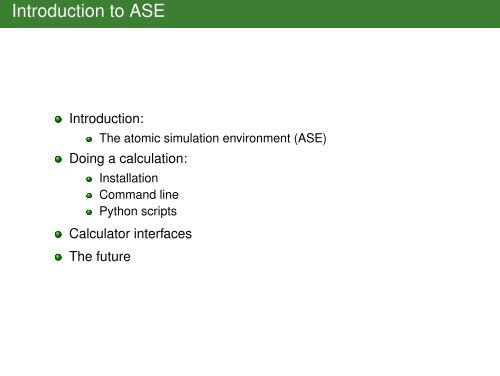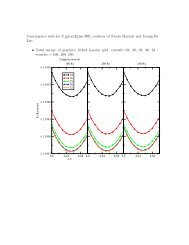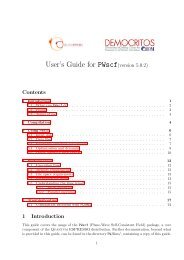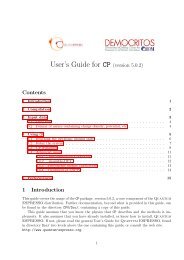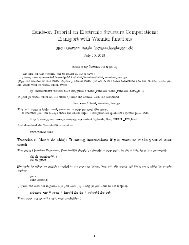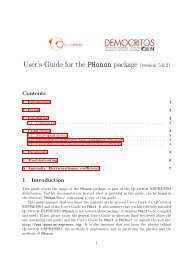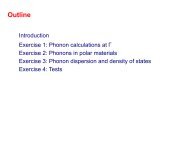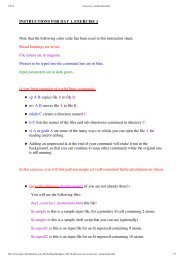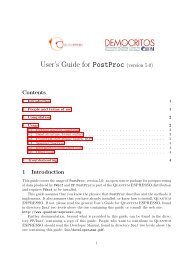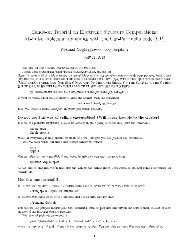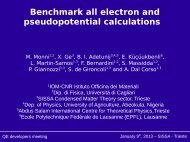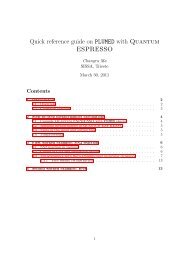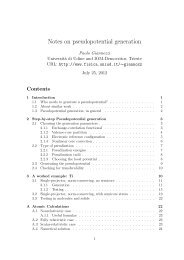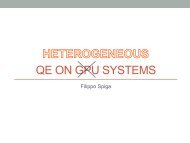Introduction to ASE - Quantum Espresso
Introduction to ASE - Quantum Espresso
Introduction to ASE - Quantum Espresso
Create successful ePaper yourself
Turn your PDF publications into a flip-book with our unique Google optimized e-Paper software.
<strong>Introduction</strong> <strong>to</strong> <strong>ASE</strong><br />
<strong>Introduction</strong>:<br />
The a<strong>to</strong>mic simulation environment (<strong>ASE</strong>)<br />
Doing a calculation:<br />
Installation<br />
Command line<br />
Python scripts<br />
Calcula<strong>to</strong>r interfaces<br />
The future
The a<strong>to</strong>mic simulation environment (<strong>ASE</strong>) Python package<br />
Calcula<strong>to</strong>rs with <strong>ASE</strong> interface:<br />
We use <strong>ASE</strong> for structure optimization, molecular dynamics,<br />
handling constraints, nudged elastic band calculations, vibrational<br />
analysis, simulated STM images, calculation of Wannier<br />
functions, transport calculations and much more<br />
<strong>ASE</strong> also has a graphical user interface and a rich set of file-IO<br />
formats<br />
http://wiki.fysik.dtu.dk/ase
<strong>ASE</strong>-calcula<strong>to</strong>r interface<br />
For <strong>ASE</strong>, a calcula<strong>to</strong>r is a black box that can calculate energies, forces<br />
and stresses. From <strong>ASE</strong> it will get:<br />
a<strong>to</strong>mic positions<br />
a<strong>to</strong>mic numbers<br />
the unit cell<br />
boundary conditions<br />
and maybe also magnetic moments and charges.<br />
More advanced interface:<br />
Eigenvalues.<br />
Electron densities.<br />
Wave functions.<br />
...
Installing <strong>ASE</strong><br />
$ svn co https://svn.fysik.dtu.dk/projects\<br />
> /ase/trunk ase<br />
$ export PYTHONPATH=~/ase<br />
$ export PATH=$PATH:~/ase/<strong>to</strong>ols<br />
$ testase
Where is what?<br />
~/ase/ase:<br />
The <strong>ASE</strong> code.<br />
~/ase/ase/calcula<strong>to</strong>rs:<br />
Python wrappers for electronic structure codes and<br />
empirical potentials.<br />
~/ase/doc:<br />
Documentation (same as on the web-pages).<br />
~/ase/<strong>to</strong>ols:<br />
Tools such as <strong>ASE</strong>’s GUI (ag)
Running a calculation<br />
Command-line interface (still experimental):<br />
$ ase abinit H2 -p ecut=400,xc=PBE -R 0.05<br />
Similar Python script using another calcula<strong>to</strong>r:<br />
from ase.structure import molecule<br />
from ase.optimize import BFGS<br />
from gpaw import GPAW<br />
h2 = molecule(’H2’)<br />
h2.center(vacuum=3)<br />
h2.calc = GPAW(mode=’lcao’,<br />
basis=’dzp’,<br />
xc=’PBE’,<br />
txt=’H2.txt’)<br />
opt = BFGS(h2, trajec<strong>to</strong>ry=’H2.traj’)<br />
opt.run(fmax=0.05)<br />
h2.calc.write(’H2.gpw’)
More <strong>ASE</strong> stuff<br />
Alternative <strong>to</strong> molecule() function:<br />
from ase import A<strong>to</strong>ms<br />
h2 = A<strong>to</strong>ms(’H2’, [(0, 0, 0), (0, 0, 0.74)])<br />
or:<br />
from ase.io import read<br />
h2 = read(’H2.traj’)<br />
There is also a bulk() function and, and, and ...<br />
Use <strong>ASE</strong>’s GUI called ag. It understands the same file-formats<br />
as <strong>ASE</strong>’s read() function: CIF, PDB, CUBE, XYZ, <strong>ASE</strong>’s .traj<br />
files and many mode.
More <strong>ASE</strong> things<br />
How <strong>to</strong> use sys.argv, other <strong>ASE</strong> functions, for-loops and string<br />
interpolation:<br />
import sys<br />
from ase.lattice.surface import fcc111<br />
from gpaw import GPAW, PW<br />
a = float(sys.argv[1])<br />
k = int(sys.argv[2])<br />
for n in range(1, 5):<br />
slab = fcc111(’Cu’, size=(1, 1, n),<br />
a=a, vacuum=5.0)<br />
slab.calc = GPAW(mode=PW(ecut=400),<br />
kpts=(k, k, 1),<br />
txt=’Cu%d.txt’ % n)<br />
slab.get_potential_energy()
Different types of calcula<strong>to</strong>rs<br />
1) <strong>ASE</strong> writes input file<br />
2) <strong>ASE</strong> starts Fortran code (maybe in parallel)<br />
3) <strong>ASE</strong> waits for Fortran code <strong>to</strong> finish<br />
4) <strong>ASE</strong> reads output file<br />
Same as above, except that the Fortran code doesn’t s<strong>to</strong>p - it<br />
waits for a new input file with new coordinates (dacapo).<br />
Pure Python solution. For parallel calculations, the Python<br />
interpreter runs on all processes (GPAW).
What is GPAW?<br />
An implementation of the projec<strong>to</strong>r-augmented wave (PAW)<br />
method<br />
Wave functions are described using<br />
1) real-space uniform grids (fd)<br />
2) a<strong>to</strong>m-centered numerical basis functions (lcao)<br />
3) plane-waves (pw)<br />
It’s written in a combination of the Python and C languages<br />
It’s based on <strong>ASE</strong> and NumPy (a Python library for manipulating<br />
N-dimensional arrays of numbers)<br />
It uses these libraries for the hard work:<br />
BLAS<br />
LAPACK and optionally ScaLAPACK and BLACS<br />
MPI (if you want <strong>to</strong> run GPAW in parallel - which you do)<br />
FFTW (if you want <strong>to</strong> do fast plane-wave based calculations)<br />
The license is GPLv3+
The future<br />
Au<strong>to</strong>matic testing of all calcula<strong>to</strong>r interfaces<br />
New trajec<strong>to</strong>ry file format<br />
...
Finally ...<br />
Check out the webpage:<br />
http://wiki.fysik.dtu.dk/ase<br />
Thanks <strong>to</strong> all contributers<br />
Talk <strong>to</strong> us on our mailing lists: ase-developers, and<br />
ase-users<br />
Thank you for your attention


